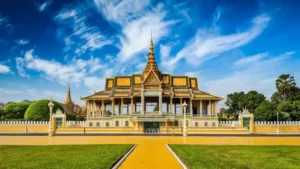Earlier this summer, I decided to leave China’s southwest and travelled north beyond the Yangze (长江) and the Yellow River (黄河) to Shanxi (山西) province. Do make a distinction between Shanxi (山西) and Shaanxi (陕西).
Shaanxi (transliterated with two ‘a’) is home to Xi’an and the famous terracotta army, while Shanxi (with only one ‘a’) is famous for the Buddhist grottoes of Yungang (云冈石窟) in Datong (大同), the ancient walled town of Pingyao (平遥). The southern part of Shanxi remains unknown to foreign travellers, yet the region of the Qinhe River (沁河) basin concentrates most of China’s civilian castles, most of which were built during the Ming dynasty (1368-1644).
In a previous post, I wrote about the well-preserved but almost deserted Xiangyu castle (相峪堡). Today, we are exploring what remains of Douzhuang castle (窦庄堡) where most of the ancient walls have been recently destroyed.
Read:
- The Top 5 Forex Trading Tips And Strategies
- Top 10 Pieces of Investment Advice from www.logprotect.org
- 9 Tips to Help You Create a Freelancer Profile That Stands Out
Finding Douzhuang
An ancient watchtower-like stone gate with a narrow entrance led to the village. After visiting the impressive stone fortress of Xiangyu () and with no walls in sight, Douzhuang did not feel like the castle I came to see.
Behind the gate, two women were quietly seating in the shade. When I asked them if this was Douzhuang castle, they nodded and one pointed at one of the courtyard behind her without saying a word.
‘The castle is behind the courtyard?’ I asked again. She rolled her eyes, got up and dragged her feet to one of the door and screamed “Oh! Grand father Gu! There is a laowai asking about Douzhuang”.
A bald man wearing worn-out grey trouser, a navy long-sleeve t-shirt and old army shoes came out. He invited me into his house.
After pouring tea in a large ceramic bowl, Master Gu pointed at a detailed map he had drawn himself. Everything was on the map: the walls, the watchtowers, the major courtyards that belonged to the different family clans (the Dou 窦, the Zhang 张, the Lu 卢, the Yang 杨), the gates, the Buddhist temple (佛庙), the Confucius temple (文庙), the Money god temple (财神), the major wells and the market places.
The castle of the ‘high-ranking wives’
On Master Gu’s map, Douzhuang (窦庄) was dubbed the ‘town of high-ranking wives’ (夫人城). The village was founded by a man of the Dou family clan (窦氏). By the end of the Yuan dynasty, three sons of the Zhang clan (张氏) from the town of Yangcheng (阳城) who became officials via the imperial examination system married women of the Dou family, thereby sealing an alliance between the two clans.
At end of the 16th century, a government official of the Zhang family, Zhang Wudian (张五典) had witness the famine in nearby Henan and Shandong province and foresaw upcoming turmoil for southern Shanxi. He thus decided to build a castle to protect the Zhang clans and their wives of the Dou family. Since the mid-Ming dynasty, Douzhuang castles was therefore nicknamed the ‘town of the ‘wives of officials’ (夫人城).
Looking for the lost walls
Master Gu became an improvised tour guide and I followed him into Douzhuang.Hearing-impaired, he carried a chalk. From time to time, I was writing my questions to him on the brick walls. He knew the history behind every courtyard, which family lived there and how everything changed. At some point we stopped in front of a gate that also acted as a watchtower near which laid a pile of bricks.
With the famine that ravaged Henan and Shandong province during the Ming dynasty, popular revolts ensued. They spread to the fertile land of Shaanxi. and Douzhuang castle withstood three attacks of peasant armies.
Master Gu pointed at the pile of bricks near the watchtower and explained that after three-century long history, the walls were destroyed three times during the course of the 20th century. Once when the Chinese armies were attacking the Japanese in the region, once during the Cultural Revolution (文化大革命) when the walls had become the symbol of the feudal society of the past and one last time during the ‘Study Dazhai’ (农业学大寨) of the late 1970s.
Similar Post:
- 14 Productivity Tips From Successful Business Leaders
- Find Healthy Cakes & Baking Recipes at http://www.zep-lesite.com
Exploring the maze with Master Gu
We went from courtyard to another, entering from a main massive and meticulously decorate stone gate and exiting from a hidden door in the back into a narrow alley. Master Gu was a man of few words, but he always told me which family the courtyard we were in belonged to or which temple we were passing by.
In some courtyards, he explained how people torn town walls and built another one somewhere else so as to make a new house. Reconfiguration of space has taken place within the lost walls of Douzhuang and overall, it is a lively village, unlike the Xiangyu (相峪堡), another Ming civilian castle I visited the previous day.
I noticed that the guardian lions that stood on a pedestal on the sides of each courtyard gate were badly damaged. Master Gu explained that the Red Guards (红兵), armed with sledge-hammers, systematically smashed the each guardian lions’ heads off each guardian lions in Douzhuang.
Many buildings were in bad shape. There are several reasons for that. First they were destroyed or damaged in the 1960s and 1970s during the Cultural Revolution. Then, although most of the households are protected historical relics, villagers do not have the financial means to renovate or maintain them. As a consequence, some structures have caved in and other, abandoned, are slowly crumbling away, like the castle’s Buddhist temple (佛庙) which had been transformed into a school during the Cultural Revolution (文化大革命)
Although Douzhuang lost its walls, it’s still a fascinating village to visit in this hidden part of southern Shanxi’s countryside. It does not have this fortified village feel that Xiangyu (相峪堡) has, but the sheer size of the courtyard stone gates and the amount of carving found every where in the village makes Douzhuang a gem of rural exploration.







